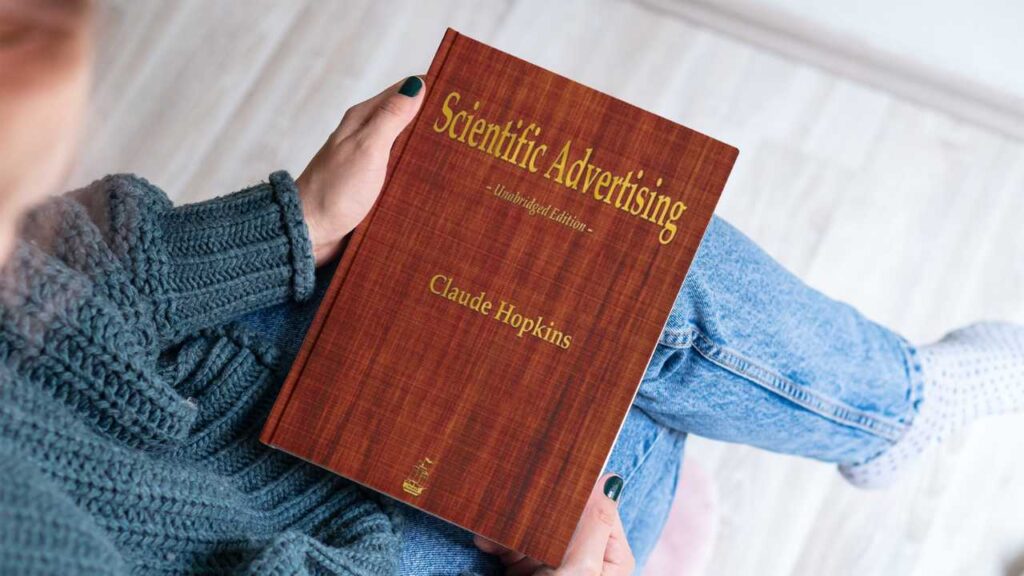MARKETING
3 Classic Copywriting Books You Need Now More than Ever


Classic copywriting books are needed now more than ever. With the explosion of marketing technology, AI-generated content, and companies worldwide competing for the same customers, timeless principles are priceless.
Because although AI can generate content, understanding human emotions and psychology, as taught in these books, is essential for creating an engaging and persuasive copywriting piece.
With all our new technology, it’s easy to get pulled away from the fundamentals of copywriting. However, when you combine the fundamentals with modern technology, you become unstoppable.
Breakthrough Advertising By Eugene Schwartz


Breakthrough Advertising is a favorite among copywriters. Eugene Schwartz, a direct-response copywriter who was prolific in the mid-20th century, is a legend.
Breakthrough Advertising is a dense book, and most reviews will only cite the Schwartz lessons from the first half. For example, almost every review will cite Schwartz’s advice that demand for a product cannot be created—only channeled.
(I guess I just did it too.)
That advice about customer demand is indeed sage wisdom to write down and remember forever. But it’s in the second half of the Breakthrough Advertising, which gets little attention, where I find the most gems.
One of those gems is Schwartz writing about the topic of belief.
Belief is the goal, Schwartz states.
If you can channel the tremendous force of his belief—either in content or direction—behind only one claim, no matter how small, then that one fully-believed claim will sell more goods than all the half-questioned promises your competitors can write for all the rest of their days.
A prospect can’t fully accept and value your offer unless you build the necessary beliefs. Your coupons and bonuses will bounce right off your prospects unless they believe your product is right for them.
As an example, Schwartz describes a challenge he had in selling a TV repair manual. Back in the 1950’s, TVs were complex, intimidating machines that broke down constantly, leading to expensive repair bills.
The homeowner could save a ton of money doing TV repairs themselves. The problem was that nobody believed they could actually repair a TV.
Schwartz persuaded prospects they could repair the TV using nothing but his words. He did it through the way he structured his sales letter, strategically targeting belief after belief. You can find the full sales letter in Breakthrough Advertising—it’s incredible.
HOW TO USE THIS BOOK TODAY:
These days, the marketing world is filled with hype and over-the-top promises. Schwartz advises us to dial down those big promises. Instead, focus on building belief. Put yourself in your prospect’s shoes and ask, “What does my prospect need to believe in order to say “yes” to my offer?
If you want more on this topic of belief building in your prospect’s mind, I teach a step-by-step process in my own, Simple Marketing for Smart People.
The Robert Collier Letter Book


Robert Collier built a successful direct-response marketing business by sending simple letters in the mail.
He used letters to sell all sorts of products, from coal (Collier was a mining engineer) to women’s dresses. But he mainly sold books.
The books were typically stories from history, such as H.G. Wells’s The Outline of History, or personal development books around achievement and success. Collier sold over 300,000 copies of his personal development book called The Secret of the Ages.
His letters were clear, compelling, and most importantly—human.
Collier has a way of writing that makes you feel like he’s writing you a personal letter even though has was mailing these letters to thousands of people.
One notable letter was written to mothers and sold a home study course. It has the headline: “There is No University Like a Mother’s Reading to Her Child.”
Really tugs on the heartstrings, doesn’t it? That’s classic Collier.
Now, these letters were not merely for entertainment. He calls the letters he writes “Resultful Letters,” meaning the letters had to lead to results. That is, a purchase.
But it’s Collier’s way of getting the reader to take action (i.e., to purchase the product) that sets him apart.
His approach centers on knowing your reader. Collier states:
Familiarity with the thing you are selling is an advantage, but the one essential without which success is impossible in selling, by mail or selling in person, is a thorough understanding of human reactions. Study your reader first—your product second. If you understand his reactions and present those phases of your product that relate to his needs, then you cannot help but write a good letter.
Wise words for today’s copywriter.
HOW TO USE THIS BOOK TODAY:
Use The Robert Collier Letter to add a human element to your writing. This book is different in that it’s learn by example. There’s not as much teaching as other copywriting books, but rather, you learn from Collier’s example letters, of which there are dozens.
Read Collier’s letters, his commentary, and his approach will sink in. The next time you sit down to write copy, you’ll naturally harness your inner Collier.
Scientific Advertising by Claude Hopkins


Claude Hopkins is a pioneering figure in advertising. His most famous book, Scientific Advertising, is short at just 87 pages. Yet, it’s still constantly referenced for its timeless principles.
In Scientific Adveritsing, Hopkins writes:
The lack of fundamentals has been the main trouble with advertising in the past . . . it was like a man trying to build a modern locomotive without first asserting what others had done.
Hopkins laments that advertising success has felt like too much of a gamble, too much too much like speculation, like betting at the race track.
Do you see how even today, we’re wrestling with the same problem? We roll out a new product launch, ad campaign, or VSL, and it feels like we’re rolling the dice.
Hopkins believed advertising could be a safe and sure venture. But in order to do so, we must learn the fundamentals.
Hopkins then walks through his nearly 20 laws of advertising. He covers everything from headlines to distribution to giving samples. That last law, giving samples, was one of Hopkin’s favorite techniques. He sold a mountain of products by giving away samples. Hopkins believed the product should be its own best salesman.
HOW TO USE THIS BOOK TODAY:
Each of Hopkin’s laws can be applied today. For example, his law of giving samples is easier than ever thanks to shipping across the world being easier than ever.
His law on individuality and adding personality to your copy is critical given the massive amount of content on the internet and the difficulty of standing out.
Weave Hopkin’s laws into your next copywriting project and enjoy the results.
Your Turn
The benefit of learning copywriting from history’s greats is that they weren’t distracted by the internet and modern technology. That meant they put all their effort into the only tool they had—their words.
Study these great books to learn the timeless principles that lead to high-converting copy. Then, combine those principles with modern technology and watch your results soar.
MARKETING
YouTube Ad Specs, Sizes, and Examples [2024 Update]
![YouTube Ad Specs, Sizes, and Examples [2024 Update] YouTube Ad Specs, Sizes, and Examples](https://articles.entireweb.com/wp-content/uploads/2024/06/YouTube-Ad-Specs-Sizes-and-Examples.jpg)
Introduction
With billions of users each month, YouTube is the world’s second largest search engine and top website for video content. This makes it a great place for advertising. To succeed, advertisers need to follow the correct YouTube ad specifications. These rules help your ad reach more viewers, increasing the chance of gaining new customers and boosting brand awareness.
Types of YouTube Ads
Video Ads
- Description: These play before, during, or after a YouTube video on computers or mobile devices.
- Types:
- In-stream ads: Can be skippable or non-skippable.
- Bumper ads: Non-skippable, short ads that play before, during, or after a video.
Display Ads
- Description: These appear in different spots on YouTube and usually use text or static images.
- Note: YouTube does not support display image ads directly on its app, but these can be targeted to YouTube.com through Google Display Network (GDN).
Companion Banners
- Description: Appears to the right of the YouTube player on desktop.
- Requirement: Must be purchased alongside In-stream ads, Bumper ads, or In-feed ads.
In-feed Ads
- Description: Resemble videos with images, headlines, and text. They link to a public or unlisted YouTube video.
Outstream Ads
- Description: Mobile-only video ads that play outside of YouTube, on websites and apps within the Google video partner network.
Masthead Ads
- Description: Premium, high-visibility banner ads displayed at the top of the YouTube homepage for both desktop and mobile users.
YouTube Ad Specs by Type
Skippable In-stream Video Ads
- Placement: Before, during, or after a YouTube video.
- Resolution:
- Horizontal: 1920 x 1080px
- Vertical: 1080 x 1920px
- Square: 1080 x 1080px
- Aspect Ratio:
- Horizontal: 16:9
- Vertical: 9:16
- Square: 1:1
- Length:
- Awareness: 15-20 seconds
- Consideration: 2-3 minutes
- Action: 15-20 seconds
Non-skippable In-stream Video Ads
- Description: Must be watched completely before the main video.
- Length: 15 seconds (or 20 seconds in certain markets).
- Resolution:
- Horizontal: 1920 x 1080px
- Vertical: 1080 x 1920px
- Square: 1080 x 1080px
- Aspect Ratio:
- Horizontal: 16:9
- Vertical: 9:16
- Square: 1:1
Bumper Ads
- Length: Maximum 6 seconds.
- File Format: MP4, Quicktime, AVI, ASF, Windows Media, or MPEG.
- Resolution:
- Horizontal: 640 x 360px
- Vertical: 480 x 360px
In-feed Ads
- Description: Show alongside YouTube content, like search results or the Home feed.
- Resolution:
- Horizontal: 1920 x 1080px
- Vertical: 1080 x 1920px
- Square: 1080 x 1080px
- Aspect Ratio:
- Horizontal: 16:9
- Square: 1:1
- Length:
- Awareness: 15-20 seconds
- Consideration: 2-3 minutes
- Headline/Description:
- Headline: Up to 2 lines, 40 characters per line
- Description: Up to 2 lines, 35 characters per line
Display Ads
- Description: Static images or animated media that appear on YouTube next to video suggestions, in search results, or on the homepage.
- Image Size: 300×60 pixels.
- File Type: GIF, JPG, PNG.
- File Size: Max 150KB.
- Max Animation Length: 30 seconds.
Outstream Ads
- Description: Mobile-only video ads that appear on websites and apps within the Google video partner network, not on YouTube itself.
- Logo Specs:
- Square: 1:1 (200 x 200px).
- File Type: JPG, GIF, PNG.
- Max Size: 200KB.
Masthead Ads
- Description: High-visibility ads at the top of the YouTube homepage.
- Resolution: 1920 x 1080 or higher.
- File Type: JPG or PNG (without transparency).
Conclusion
YouTube offers a variety of ad formats to reach audiences effectively in 2024. Whether you want to build brand awareness, drive conversions, or target specific demographics, YouTube provides a dynamic platform for your advertising needs. Always follow Google’s advertising policies and the technical ad specs to ensure your ads perform their best. Ready to start using YouTube ads? Contact us today to get started!
MARKETING
Why We Are Always ‘Clicking to Buy’, According to Psychologists

Amazon pillows.
MARKETING
A deeper dive into data, personalization and Copilots

Salesforce launched a collection of new, generative AI-related products at Connections in Chicago this week. They included new Einstein Copilots for marketers and merchants and Einstein Personalization.
To better understand, not only the potential impact of the new products, but the evolving Salesforce architecture, we sat down with Bobby Jania, CMO, Marketing Cloud.
Dig deeper: Salesforce piles on the Einstein Copilots
Salesforce’s evolving architecture
It’s hard to deny that Salesforce likes coming up with new names for platforms and products (what happened to Customer 360?) and this can sometimes make the observer wonder if something is brand new, or old but with a brand new name. In particular, what exactly is Einstein 1 and how is it related to Salesforce Data Cloud?
“Data Cloud is built on the Einstein 1 platform,” Jania explained. “The Einstein 1 platform is our entire Salesforce platform and that includes products like Sales Cloud, Service Cloud — that it includes the original idea of Salesforce not just being in the cloud, but being multi-tenancy.”
Data Cloud — not an acquisition, of course — was built natively on that platform. It was the first product built on Hyperforce, Salesforce’s new cloud infrastructure architecture. “Since Data Cloud was on what we now call the Einstein 1 platform from Day One, it has always natively connected to, and been able to read anything in Sales Cloud, Service Cloud [and so on]. On top of that, we can now bring in, not only structured but unstructured data.”
That’s a significant progression from the position, several years ago, when Salesforce had stitched together a platform around various acquisitions (ExactTarget, for example) that didn’t necessarily talk to each other.
“At times, what we would do is have a kind of behind-the-scenes flow where data from one product could be moved into another product,” said Jania, “but in many of those cases the data would then be in both, whereas now the data is in Data Cloud. Tableau will run natively off Data Cloud; Commerce Cloud, Service Cloud, Marketing Cloud — they’re all going to the same operational customer profile.” They’re not copying the data from Data Cloud, Jania confirmed.
Another thing to know is tit’s possible for Salesforce customers to import their own datasets into Data Cloud. “We wanted to create a federated data model,” said Jania. “If you’re using Snowflake, for example, we more or less virtually sit on your data lake. The value we add is that we will look at all your data and help you form these operational customer profiles.”
Let’s learn more about Einstein Copilot
“Copilot means that I have an assistant with me in the tool where I need to be working that contextually knows what I am trying to do and helps me at every step of the process,” Jania said.
For marketers, this might begin with a campaign brief developed with Copilot’s assistance, the identification of an audience based on the brief, and then the development of email or other content. “What’s really cool is the idea of Einstein Studio where our customers will create actions [for Copilot] that we hadn’t even thought about.”
Here’s a key insight (back to nomenclature). We reported on Copilot for markets, Copilot for merchants, Copilot for shoppers. It turns out, however, that there is just one Copilot, Einstein Copilot, and these are use cases. “There’s just one Copilot, we just add these for a little clarity; we’re going to talk about marketing use cases, about shoppers’ use cases. These are actions for the marketing use cases we built out of the box; you can build your own.”
It’s surely going to take a little time for marketers to learn to work easily with Copilot. “There’s always time for adoption,” Jania agreed. “What is directly connected with this is, this is my ninth Connections and this one has the most hands-on training that I’ve seen since 2014 — and a lot of that is getting people using Data Cloud, using these tools rather than just being given a demo.”
What’s new about Einstein Personalization
Salesforce Einstein has been around since 2016 and many of the use cases seem to have involved personalization in various forms. What’s new?
“Einstein Personalization is a real-time decision engine and it’s going to choose next-best-action, next-best-offer. What is new is that it’s a service now that runs natively on top of Data Cloud.” A lot of real-time decision engines need their own set of data that might actually be a subset of data. “Einstein Personalization is going to look holistically at a customer and recommend a next-best-action that could be natively surfaced in Service Cloud, Sales Cloud or Marketing Cloud.”
Finally, trust
One feature of the presentations at Connections was the reassurance that, although public LLMs like ChatGPT could be selected for application to customer data, none of that data would be retained by the LLMs. Is this just a matter of written agreements? No, not just that, said Jania.
“In the Einstein Trust Layer, all of the data, when it connects to an LLM, runs through our gateway. If there was a prompt that had personally identifiable information — a credit card number, an email address — at a mimum, all that is stripped out. The LLMs do not store the output; we store the output for auditing back in Salesforce. Any output that comes back through our gateway is logged in our system; it runs through a toxicity model; and only at the end do we put PII data back into the answer. There are real pieces beyond a handshake that this data is safe.”
-

 SEARCHENGINES5 days ago
SEARCHENGINES5 days agoBillions Of Google goo.gl URLs To 404 In The Future
-

 SEO7 days ago
SEO7 days ago26 Common SEO Myths, Debunked
-
SEARCHENGINES4 days ago
Daily Search Forum Recap: July 22, 2024
-

 SEO5 days ago
SEO5 days ago11 Copyscape Alternatives To Check Plagiarism
-

 SEARCHENGINES6 days ago
SEARCHENGINES6 days agoGoogle Core Update Coming, Ranking Volatility, Bye Search Notes, AI Overviews, Ads & More
-

 SEO6 days ago
SEO6 days agoGoogle Warns Of Last Chance To Export Notes Search Data
-
SEARCHENGINES3 days ago
Daily Search Forum Recap: July 23, 2024
-

 AFFILIATE MARKETING6 days ago
AFFILIATE MARKETING6 days agoThe Top 5 AI Tools That Can Revolutionize Your Workflow and Boost Productivity
















